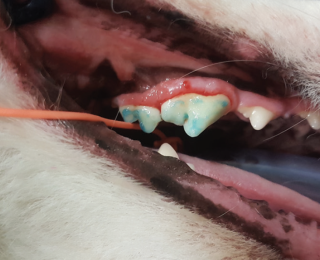Focus > Diagnostics - June 2020
Dental care: a prophylactic approach
John Breen BSc. VN outlines the importance of prophylactically treating dental disease, something that can often be overlooked by both vets and nurses
Click on image to view
For the cases that we know would benefit from prophylactic treatment (our very dental-disease-prone Yorkshire Terriers, for example), our arsenal of products is limited to what the customer can potentially purchase in the local pet shop, or to the one product bought on special last year that we don’t really know much about.
Not only is prophylactic treatment itself important and something we should include as part of our routine dental procedures, it is also important that we use and supply products that have concrete evidence associated with them in relation to their efficacy, and that we believe in these products ourselves.
We are all very familiar with the saying ‘prevention is better than cure’ and, while dental disease is a continuous issue that we cannot simply cure after one descale and polish procedure, we can help prevent the speed and severity at which it returns through prophylactic care. This not only aids our patients medically; it yields results that owners can see so they can begin to appreciate the value of dentistry for their pet.
We visit our own dentists once, maybe twice, a year and in between we brush our teeth twice a day. Animals should not veer far away from the routine care we provide for ourselves; one dental procedure is not enough to maintain dental health for two or more years.
There is no shortage of choice when it comes to homecare products or prophylactic treatments but siphoning out the ones that work from the ones that have limiting results can be difficult. A little research can go a long way. Treatments boil down to a few core categories.
Water additives
Water additives are an easy homecare product that require virtually no work from the owner. Volumes change depending on the brand, but the same principle applies; a solution is added to the dog or cat’s water bowl that will get to work in the mouth as they drink – a mouthwash for your pet!
However, the difficulty with water additives is that there is an abundance of them out there, and not all of them actively work to improve dental health, with a common trend being the use of scents to mask an animal’s bad breath. These additives are problematic because they don’t tackle the problem, they simply cover it up with a minty fresh smell that is short lived, has poor palatability (especially in cats) and often uses trace amounts of ingredients like xylitol and sorbitol to achieve it.
Others use a cocktail of various mild chemicals that can dilute the bacterial load and rinse the mouth but do little more than that. While the process of diluting and rinsing does contribute to improved oral health, it is only effective when bacterial numbers are low and haven’t formed significant plaque biofilms and tartar which require scaling to properly remove.
When looking for a good water additive, search for one that has studies to back it up. You want one that isn’t restricted by palatability issues, doesn’t use ingredients that are toxic (even if they are below toxic levels) and actively works to reduce bacteria in the mouth as it rinses, therefore, slowing plaque and tartar buildup and combating bad breath.
Toothbrushing
Much like water additives, toothbrushing gets the owner involved so they value their pet’s dental health and can be proud that they are making a difference themselves. Toothbrushing, while not possible for every patient, is the gold standard of homecare treatment as it combines the composition of a good water additive with the mechanical effect of brushing to scrub away the plaque as it builds. While it won’t stop the need for future dental treatments, it does make a huge difference to the degree of disease that can develop and the speed at which plaque and tartar return. As with water additives, it’s important to source a product that does more than provide a lubrication to brush. You want one that, again, has studies to show it does more than that. It’s comparable to when we shop for our own toothpaste – we want to find one that gives us a little more bang for our buck, one that provides several benefits.













